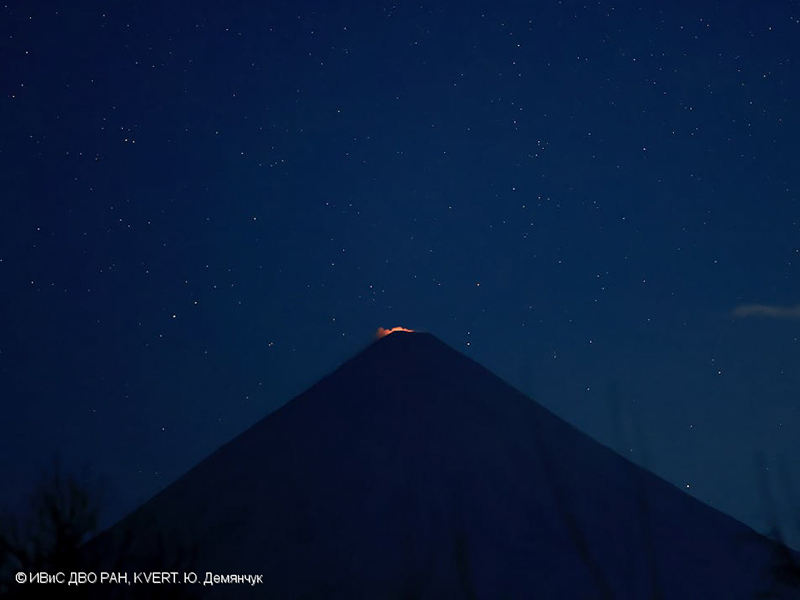Report on Klyuchevskoy (Russia) — December 2022
Bulletin of the Global Volcanism Network, vol. 47, no. 12 (December 2022)
Managing Editor: Edward Venzke.
Research and preparation by Paul Berger.
Klyuchevskoy (Russia) Strombolian eruption in November 2022
Please cite this report as:
Global Volcanism Program, 2022. Report on Klyuchevskoy (Russia) (Venzke, E., ed.). Bulletin of the Global Volcanism Network, 47:12. Smithsonian Institution.
Klyuchevskoy
Russia
56.056°N, 160.642°E; summit elev. 4754 m
All times are local (unless otherwise noted)
Klyuchevskoy is one of the most active stratovolcanoes in Russia’s northern Kamchatka Peninsula. After almost three months of inactivity, renewed eruptions in October 2020 included Strombolian activity, explosions, lava flows, and ash plumes (BGVN 45:09). Strong activity continued through January 2021, but then decreased in February, although lava flows, Strombolian activity, and gas-and steam emissions were still present through mid-March (BGVN 46:04). This report covers activity from April 2021 through December 2022, including a short eruption in November, and is based on information provided by the Kamchatkan Volcanic Eruption Response Team (KVERT) and satellite data. During this period, the volcano was inactive until November 2022 when a new eruption phase began.
On several occasions during the reporting period, high winds resuspended unconsolidated ash from the flanks to form plumes (table 18), prompting KVERT to raise the Aviation Color Code (ACC) to Orange (the second highest level on a four-color scale). Each time, the ACC was lowered to Green over the next one to three days, as conditions quieted. These events were not renewed volcanic activity.
Table 19. Dates reported by KVERT during September 2021-September 2022 when high winds resuspended loose ash on Klyuchevskoy’s flanks, prompting an Aviation Color Code increase.
| Dates | Plume altitude | Drift |
| 29 Sep 2021 | 3-5 km | 75 km E |
| 25-26 Aug 2022 | -- | 205 km E |
| 04-05 Sep 2022 | 3-4 km | 180 km E |
| 21-23 Sep 2022 | 3.5-4.5 km | 460 km SE |
On 17 November 2022 at 2330 local time, an explosive Strombolian eruption began, along with gas-and-steam plumes. A thermal anomaly had been detected starting on 13 November, and intensified when the Strombolian activity began. Lava fountaining at the summit was visible and a thermal anomaly over the summit was identified in satellite images during 17-20 and 24 November. The eruption persisted, and on 20 November (figure 74), KVERT raised the ACC to Yellow (the second lowest level). The eruption continued through at least 26 November and possibly until 5 December. On 1 December, possible ash plumes rose 150 m above the summit. KVERT began to characterize the activity as moderate on 6 December, and on the 22nd KVERT lowered the ACC to Green. On their volcano summary page KVERT listed the eruption dates as 16-26 November 2022.
 |
Figure 74. Image of incandescence above the crater from renewed eruptive activity at Klyuchevskoy on 20 November 2022. Photo by Y. Demyanchuk, courtesy of KVERT. |
The MIROVA thermal detection system recorded a few low-power thermal anomalies within 5 km of the summit, some of which included November 2022 eruption period. Sentinel-2 thermal data compiled by MIROVA also showed summit thermal anomalies during the November activity. The HIGP MODVOLC Thermal Alerts System recorded one weak anomaly on 20 November.
Geological Summary. Klyuchevskoy is the highest and most active volcano on the Kamchatka Peninsula. Since its origin about 6,000 years ago, this symmetrical, basaltic stratovolcano has produced frequent moderate-volume explosive and effusive eruptions without major periods of inactivity. It rises above a saddle NE of Kamen volcano and lies SE of the broad Ushkovsky massif. More than 100 flank eruptions have occurred during approximately the past 3,000 years, with most lateral craters and cones occurring along radial fissures between the unconfined NE-to-SE flanks of the conical volcano between 500 and 3,600 m elevation. Eruptions recorded since the late 17th century have resulted in frequent changes to the morphology of the 700-m-wide summit crater. These eruptions over the past 400 years have originated primarily from the summit crater, but have also included numerous major explosive and effusive eruptions from flank craters.
Information Contacts: Kamchatka Volcanic Eruptions Response Team (KVERT), Far Eastern Branch, Russian Academy of Sciences, 9 Piip Blvd., Petropavlovsk-Kamchatsky, 683006, Russia (URL: http://www.kscnet.ru/ivs/kvert/); MIROVA (Middle InfraRed Observation of Volcanic Activity), a collaborative project between the Universities of Turin and Florence (Italy) supported by the Centre for Volcanic Risk of the Italian Civil Protection Department (URL: http://www.mirovaweb.it/); Hawai'i Institute of Geophysics and Planetology (HIGP) - MODVOLC Thermal Alerts System, School of Ocean and Earth Science and Technology (SOEST), Univ. of Hawai'i, 2525 Correa Road, Honolulu, HI 96822, USA (URL: http://modis.higp.hawaii.edu/); Tokyo Volcanic Ash Advisory Center (VAAC), 1-3-4 Otemachi, Chiyoda-ku, Tokyo 100-8122, Japan (URL: http://ds.data.jma.go.jp/svd/vaac/data/).

